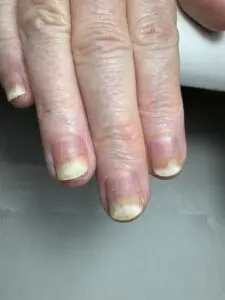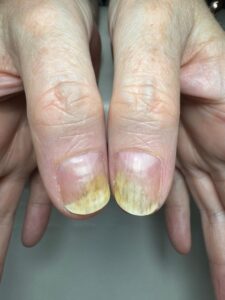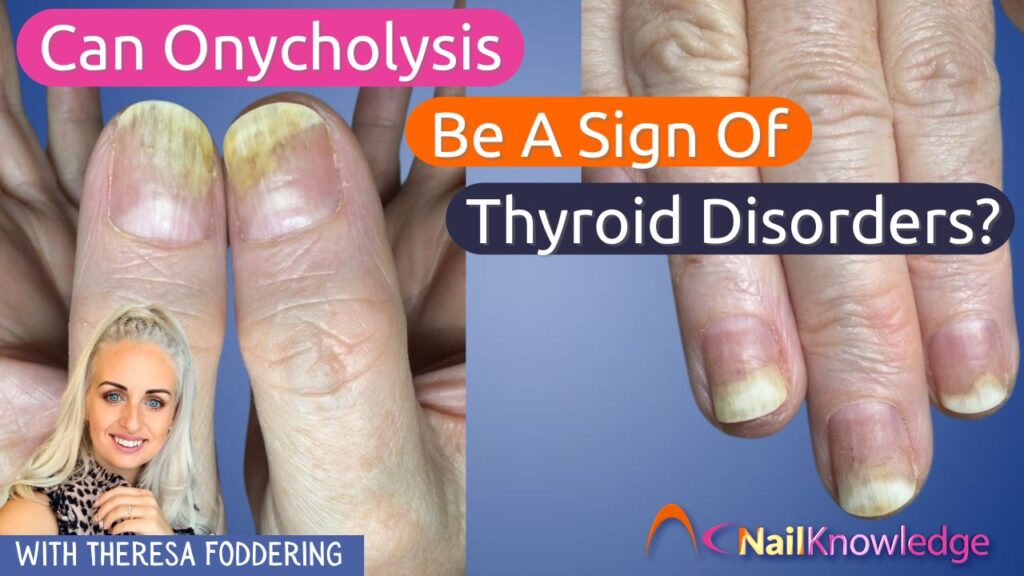Recently, I’ve been assisting a fellow professional with a particularly challenging case of long-standing onycholysis (nail separation). This client also has a history of systemic disorders, latex, and other dermatological allergies, and despite trying various treatments, applications, and products, we cannot pinpoint the root cause. Through persistent research, one issue has stood out, a serious thyroid disorder. This discovery pushed me down the rabbit hole of medical journals and publications to understand the connection between thyroid health and its effects on nails and skin. It’s a habit I’m known for, researching relentlessly to uncover answers, and this time was no different.
What I found was fascinating and deeply relevant to nail professionals. The thyroid gland, often overlooked in our industry, can profoundly affect the nails and skin, presenting signs that may otherwise be dismissed or misdiagnosed. Let’s highlight what I’ve uncovered.


El papel de la glándula tiroides
The thyroid gland is a butterfly-shaped organ located in the neck. Despite its size, it’s a powerhouse of activity, producing hormones that regulate nearly every aspect of metabolism. These hormones influence everything from cell growth and repair to energy production, heart rate, digestion, brain function, and more. In short, the thyroid is a ‘master regulator’, ensuring the body operates in balance.
Cuando la tiroides funciona mal, estos desequilibrios hormonales pueden causar problemas generalizados, incluidos cambios visibles en las uñas y la piel. Estos cambios a menudo sirven como señales de alerta temprana de problemas sistémicos más profundos.
Hipertiroidismo vs Hipotiroidismo: Las principales diferencias
Hipertiroidismo (tiroides hiperactiva)
- La tiroides produce demasiado acelerando el metabolismo.
- Síntomas: Pérdida rápida de peso, ansiedad, inquietud, intolerancia al calor, debilidad muscular y adelgazamiento de la piel o el cabello.
- Impacto en las uñas: Onycholysis (Plummer’s nails) is common, this is where the nail separates from the nail bed, often seen on the middle or ring fingers. Nails may also appear thin and fragile. (Plummer’s Nails only refers to nail separation when caused by thyroid disorders)
- Impacto en la piel: Piel sudorosa, caliente y fina, propensa al desgarro.
Hipotiroidismo (tiroides hipoactiva)
- La tiroides produce demasiado poco hormonal, ralentizando el metabolismo.
- Síntomas: Fatiga, aumento de peso, intolerancia al frío, depresión, piel seca e hinchazón.
- Impacto en las uñas: Brittle, slow-growing nails; vertical ridges; thickened nail plates; and spoon-shaped nails (Koilonychia) in severe cases.
- Impacto en la piel: Piel seca, escamosa y áspera; un tinte amarillento y retraso en la cicatrización de las heridas.
Trastornos tiroideos y salud de las uñas
Los efectos de la disfunción tiroidea en las uñas a menudo se pasan por alto o se atribuyen erróneamente. He aquí algunos cambios comunes en las uñas a tener en cuenta:
- Onicólisis (separación de las uñas):
A menudo relacionada con el hipertiroidismo, esta afección consiste en el desprendimiento de la lámina ungueal del lecho ungueal. Aunque la onicólisis también puede deberse a traumatismos, alergias o infecciones, la disfunción tiroidea es un factor crítico que a menudo se pasa por alto. - Crecimiento lento de las uñas y fragilidad:
Hypothyroidism slows the metabolic processes, leading to slow nail growth and brittle, peeling nails. - Uñas engrosadas:
In some cases of hypothyroidism, keratin build-up can cause nails to thicken, creating a rough or irregular texture. - Crestas verticales:
Las crestas prominentes en la lámina ungueal pueden deberse a una producción debilitada de queratina asociada al hipotiroidismo. - Sequedad y agrietamiento:
Los trastornos tiroideos suelen causar una falta de estado de la piel y las uñas, lo que provoca grietas, fisuras y una mayor susceptibilidad a las infecciones secundarias.
Panorama general: Sequedad, engrosamiento, crestas y onicólisis
One of the most common correlations I’ve observed over the years is the combination of nail dryness, thickening, and ridges culminating in onycholysis. Too often, onycholysis is immediately attributed to an allergic reaction, leading to incorrect advice and missed referrals. While allergies can cause nail separation, it is just one of many potential causes. By becoming overly focused on allergy as the sole explanation, we risk overlooking serious underlying health conditions like thyroid dysfunction.
For example, a client presenting with ridged, brittle nails and onycholysis may be dealing with hypothyroidism rather than an irritant. These signs demand a more holistic assessment and, where necessary, a referral to a healthcare professional.
¿Qué pueden hacer los profesionales de las uñas?
As nail professionals, our role isn’t to diagnose medical conditions, but we are often the first to notice changes in our clients’ nails and skin. Here’s how we can support them:
- Reconocer las señales:
Infórmese sobre los efectos visibles de la disfunción tiroidea en las uñas y la piel. Presta atención a patrones como crecimiento lento, uñas engrosadas u onicolisis persistente.
- Evite sacar conclusiones precipitadas:
Don’t immediately attribute nail separation to allergies or external factors. Consider the bigger picture, including systemic health issues.
- Adapte sus tratamientos:
Provide gentle, conditioning treatments to combat dryness and brittleness. Avoid aggressive, or even unnecessary, filing or buffing, which could swiftly worsen the problem.
- Fomentar la consulta profesional:
Si sospecha un problema tiroideo subyacente o cualquier posible trastorno sistémico, sugiera a su cliente que consulte a su médico de cabecera.
Mirar siempre bajo la superficie
Los trastornos tiroideos son más frecuentes de lo que muchos pensamos, sobre todo entre las mujeres mayores de 40 años o las que experimentan cambios hormonales. Sin embargo, los signos visibles en las uñas y la piel a menudo pasan desapercibidos o se atribuyen erróneamente. Como profesionales, tenemos una oportunidad única para reconocer estos signos a tiempo y orientar a nuestros clientes hacia el asesoramiento adecuado.
The case I mentioned at the start of this blog is a perfect example. By diving deeper into the possible causes of the client’s onycholysis, we uncovered a possible answer to our journey enabling us to assist her better with every service, not to mention highlighting the Nail Professionals’ expertise and professionalism against her competition but to existing and future clients. This experience reinforced the importance of staying curious, informed, and open-minded when addressing nail and skin abnormalities.
Así que la próxima vez que vea a un cliente con onicólisis persistente, uñas quebradizas o piel seca y escamosa, recuerde que podría ser más de lo que parece. Y en esos momentos, tu experiencia y orientación pueden marcar la diferencia.
Más información Onicólisis ¿y cuál es su causa?


